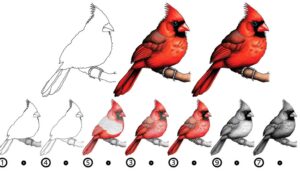How Long Do Cardinal Birds Live?
Northern Cardinals typically live around 3 years in the wild, though some can reach up to 15 years. Survival rates are lower in the first year, but once matured, adult cardinals show greater longevity.
Factors such as predation by hawks and domestic cats, environmental variables, and balanced nutrition significantly influence lifespan. Harsh weather and habitat degradation also pose significant threats.
Their diet, including seeds, fruits, and insects, plays an essential role in their health. Less common, but still notable, cardinals in captivity can live up to 28 years.
Discovering more will reveal the intricate details of their survival and longevity.

Key Takeaways
- Northern Cardinals have an average lifespan of 3 years in the wild.
- Some Northern Cardinals can live up to 15 years in the wild.
- In captivity, Northern Cardinals may live up to 28 years with proper care.
- The first-year mortality rate is high, but adult cardinals generally live longer.
- Predators, environmental factors, and nutrition significantly influence the lifespan of cardinals.
Average Lifespan of Cardinals
The average lifespan of Northern Cardinals (Cardinalis cardinalis) in the wild is approximately 3 years, although some individuals have been documented to live up to 15 years under ideal conditions. Extensive field studies indicate that life expectancy is influenced by various biotic and abiotic factors.
Data compiled from banding and recapture efforts reveal that survival rates decrease significantly in the first year, with roughly 50% of fledglings failing to reach adulthood. Adult cardinals exhibit greater longevity, benefiting from accrued survival skills and established territories.
Detailed observations suggest that avian senescence is rare; however, older cardinals exhibit reduced reproductive success and foraging efficiency. The disparity between average and maximum lifespan underscores the variability inherent in natural populations.
Factors Affecting Lifespan
Cardinal birds' lifespans are influenced by a combination of predation pressures, environmental variables, and nutritional factors. Predators such as hawks and domestic cats markedly increase mortality rates, while harsh weather conditions and habitat degradation further exacerbate survival challenges.
Additionally, access to a balanced diet rich in seeds and fruits directly impacts their health and longevity, underscoring the importance of food availability and quality in their natural habitats.
Predators and Threats
Numerous predators impact the lifespan of cardinal birds by increasing mortality rates in both juveniles and adults. Domestic cats (Felis catus) are a significant threat, responsible for an estimated 2.4 billion bird deaths annually in the United States alone.
Hawks (family Accipitridae), particularly the Cooper's hawk (Accipiter cooperii), frequently prey on adult cardinals. Snakes, such as the black rat snake (Pantherophis obsoletus), mainly target nests, leading to higher juvenile mortality rates.
Additionally, nest parasitism by brown-headed cowbirds (Molothrus ater) further reduces reproductive success. These predatory pressures contribute to a significant reduction in the lifespan of cardinals, underscoring the complex interplay between predation and avian survival.
Environmental Conditions
Environmental conditions, including climate variability, habitat availability, and food resources, greatly influence the lifespan of cardinal birds by affecting their health, reproductive success, and survival rates. Research indicates that ideal environmental conditions can greatly enhance the longevity of these birds.
Factors such as:
- Climate Stability: Consistent temperatures and precipitation reduce stress and mortality rates.
- Habitat Quality: Abundant vegetation provides shelter and nesting sites, crucial for reproduction.
- Food Accessibility: Steady food supply supports sustained energy levels and strong immune systems.
Detailed studies reveal that regions with stable climates and rich habitats witness higher cardinal survival rates. Conversely, areas experiencing habitat loss or climatic extremes often see reduced lifespans, underscoring the crucial role of environmental stability in cardinal longevity.
Diet and Nutrition
In addition to environmental conditions, the diet and nutrition of cardinal birds play an essential role in determining their lifespan. A well-balanced diet greatly enhances their health and longevity. Cardinals primarily consume seeds, fruits, and insects, which provide essential nutrients such as proteins, fats, and carbohydrates.
Studies have shown that a diet rich in high-quality seeds like sunflower and safflower seeds can greatly improve their overall vitality. Moreover, the availability of insects during breeding seasons provides important protein needed for offspring development.
Malnutrition or an imbalanced diet can lead to weakened immune systems, making cardinals susceptible to diseases and reducing their lifespan. Ensuring a diverse and nutrient-dense diet is crucial for promoting the longevity and well-being of cardinal birds.
Diet and Nutrition
Cardinal birds primarily consume a diet composed of seeds, fruits, and insects, which provides the necessary nutrients required for their survival and reproductive success. This diverse diet supports their metabolic needs and physiological functions.
Detailed observations indicate:
- Seeds: Cardinals prefer sunflower seeds, which are rich in fats and proteins, essential for energy and growth.
- Fruits: They eat various berries and fruits, which offer vitamins and antioxidants beneficial for immune function.
- Insects: During breeding season, insects like beetles and caterpillars are important protein sources for developing chicks.
These dietary components contribute to the cardinal's robust health, enhancing their longevity and resilience in varying habitats. This balanced nutrition is integral to their lifecycle, from nestlings to mature adults.
Predators and Threats
Several natural predators, including hawks, owls, and domestic cats, pose notable threats to the survival of cardinal birds. Raptors, such as Cooper's hawks, utilize their agility and speed to capture cardinals, especially during flight.
Owls, mainly nocturnal, exploit the hours of darkness to hunt these birds roosting in trees. Domestic cats, often underestimated, are responsible for a substantial number of cardinal fatalities, particularly in suburban environments. According to the American Bird Conservancy, cats kill approximately 2.4 billion birds annually in the United States, with cardinals being a common target.
Additionally, nest predation by snakes, squirrels, and blue jays further exacerbates the threat to juvenile cardinals, significantly impacting their population dynamics and longevity.
Habitat and Environment
Despite the myriad of predators, the habitat and environmental conditions cardinal birds inhabit play a key role in their survival and longevity. Cardinals mainly reside in woodlands, gardens, and shrublands, where they find ample food and shelter. Detailed observations indicate that ideal habitats feature the following:
- Thick Vegetation: Provides essential cover from predators and harsh weather.
- Plentiful Food Sources: Access to seeds, fruits, and insects supports their nutritional needs.
- Water Availability: Proximity to water bodies ensures hydration and aids in maintaining physiological functions.
These environmental factors greatly influence their lifespan, with individuals in more favorable habitats often reaching the upper limits of their potential longevity. Understanding these habitat requirements is essential for conservation efforts and habitat management.
Seasonal Variations
Seasonal variations profoundly impact cardinal birds' behaviors, including migration patterns, breeding cycles, and food availability.
Significantly, cardinals are non-migratory, which implies they face substantial climatic challenges throughout the year.
Winter months often lead to decreased food sources, compelling these birds to rely heavily on bird feeders in residential areas. Studies have shown a 30% increase in feeder visits during colder months.
Conversely, spring and summer bring an abundance of insects and seeds, enhancing nutritional intake and energy reserves.
These seasonal shifts directly influence survival rates; research indicates a higher mortality rate (approximately 20%) during harsh winters. Understanding these variations is pivotal for conservation efforts, as it allows for strategic support in critical periods.
Breeding and Reproduction
Breeding and reproduction in cardinal birds are characterized by distinct nesting habits, monogamous pair bonds, and a reproductive cycle that typically spans from March to September. During this period, female cardinals lay 2-5 eggs per clutch. The incubation period lasts approximately 11-13 days, mainly managed by the female.
Detailed observations highlight three crucial stages:
- Nest Construction: Males assist in selecting the site, while females primarily construct the nest using twigs, leaves, and grasses.
- Parental Roles: Males forage to feed the incubating females and later, the hatchlings.
- Fledging: Chicks fledge about 9-11 days post-hatching, yet remain reliant on parental care for the following weeks.
This reproductive strategy secures higher offspring survival rates.
Impact of Climate Change
Climate change distinctly alters cardinal birds' habitats and food availability, influencing their survival and reproductive success. Temperature fluctuations and altered precipitation patterns disrupt the availability of insects and seeds, essential to cardinals' diet. Moreover, shifting climates may extend breeding seasons, leading to potential mismatches between peak food availability and nestling demands.
| Climate Factor | Effect on Habitat | Consequence on Cardinals |
|---|---|---|
| Increased Temperature | Habitat Shrinkage | Reduced Nesting Sites |
| Altered Precipitation | Food Scarcity | Lower Reproductive Success |
| Extreme Weather | Habitat Destruction | Higher Mortality Rates |
| Seasonal Shifts | Misaligned Breeding Cycles | Reduced Offspring Survival |
| CO2 Levels | Plant Growth Variability | Altered Food Sources |
These environmental stressors necessitate adaptive strategies, potentially influencing cardinal longevity.
Human Interaction
Human activities considerably affect cardinal birds' habitats and behaviors, further exacerbating the challenges posed by climate change. Urbanization, deforestation, and pollution are major anthropogenic factors impacting these avian species.
Detailed observations indicate that:
- Urbanization: Cardinals adapt to urban environments, but face threats from increased predation and vehicle collisions.
- Deforestation: Habitat destruction reduces nesting sites and food availability, directly impacting cardinal population dynamics.
- Pollution: Pesticides and contaminants in water sources adversely affect cardinals' health and reproductive success.
Scientific studies link these factors to decreased lifespan and altered behaviors in cardinal birds. Urban settings, while offering novel resources, impose considerable survival challenges.
Therefore, human-induced environmental changes influence the longevity and life quality of cardinal birds.
Disease and Health Issues
Cardinal birds face several common health problems including avian pox, mycoplasmosis, and feather mites, which have a notable impact on their longevity.
Disease transmission risks are heightened in densely populated areas and during migration periods, necessitating thorough monitoring.
Effective prevention and treatment strategies, such as habitat management and targeted medical interventions, are essential for maintaining healthy cardinal populations.
Common Health Problems
Addressing common health problems in cardinal birds necessitates an understanding of prevalent diseases and health issues. This includes avian pox and mycoplasmosis, which can greatly impact their longevity and overall well-being. Avian pox is a viral infection that causes wart-like growths on the skin and mucous membranes, leading to difficulty in feeding and breathing. Mycoplasmosis, a bacterial disease, typically affects the respiratory system, manifesting as conjunctivitis and sinusitis.
Key health issues include:
- Avian Pox: Causes lesions on the skin and mucous membranes.
- Mycoplasmosis: Leads to respiratory distress, including conjunctivitis.
- Parasitic Infections: Mites and lice can cause anemia and feather damage.
Effective management and early diagnosis are essential for improving cardinal bird survival rates.
Disease Transmission Risks
Understanding the mechanisms of disease transmission among cardinal birds is essential for mitigating the spread of infections and ensuring the health of these avian populations.
Pathogens such as avian poxvirus and West Nile virus are common culprits, spreading through vectors like mosquitoes and direct contact with infected individuals. Studies indicate that densely populated bird feeders can exacerbate transmission rates, with observational data showing increased incidence of disease in areas with high feeder usage.
Additionally, fecal-oral routes, particularly in contaminated water sources, play a significant role in the propagation of gastrointestinal infections. Monitoring these transmission vectors is vital for developing targeted interventions, as indicated by epidemiological data correlating environmental factors with disease prevalence among cardinals.
Prevention and Treatment
Implementing biosecurity measures and strategic habitat management are crucial in mitigating the spread of diseases among cardinal bird populations. Effective prevention and treatment strategies involve a multifaceted approach encompassing environmental management, monitoring, and direct intervention. Key measures include:
- Sanitizing Feeders and Birdbaths: Regular cleaning with a 10% bleach solution reduces pathogen load.
- Monitoring Population Health: Systematic observation and recording of health indicators facilitate early detection of disease outbreaks.
- Habitat Management: Ensuring diverse, native vegetation supports robust immune systems and natural predator-prey dynamics.
Empirical evidence underscores the importance of these measures in reducing morbidity and mortality rates.
Proactive health management, combined with public awareness, enhances the longevity and robustness of cardinal bird populations.
Migration Patterns
The migration patterns of cardinal birds, specifically the Northern Cardinal (Cardinalis cardinalis), exhibit a remarkable degree of residential fidelity, with these birds typically remaining within a few kilometers of their established territory year-round.
Unlike many avian species that undertake long-distance migrations, Northern Cardinals are largely sedentary. Data indicates that over 90% of banded cardinals are recaptured within the same area, emphasizing their strong territorial attachment.
Seasonal habitat use varies minimally, with slight shifts to denser vegetation for winter cover. This residential behavior is thought to be advantageous for resource stability and predator avoidance.
Detailed field observations and telemetry studies confirm these patterns, providing valuable insights into their ecological adaptations and resource management strategies.
Lifespan in Captivity
Studies indicate that Northern Cardinals (Cardinalis cardinalis) can live much longer in captivity compared to their wild counterparts, with documented lifespans exceeding 20 years under ideal conditions. This extended lifespan can be attributed to several factors:
- Optimized Nutrition: Captive cardinals receive a balanced diet, ensuring all necessary nutrients are met.
- Reduced Predation: The absence of natural predators in captivity notably lowers mortality rates.
- Healthcare Access: Regular veterinary care helps in the early detection and treatment of diseases.
These conditions collectively contribute to the longevity of captive cardinals. Data demonstrates that controlled environments minimize stress and provide consistent living conditions, further enhancing their lifespan. Understanding these factors underscores the importance of ideal care in captivity, promoting the well-being of these avian species.
Tips for Helping Cardinals
To support the health and longevity of Northern Cardinals, one effective strategy involves providing a consistent supply of high-quality, nutrient-rich food sources. Ensuring a diet rich in seeds, fruits, and insects can optimize their nutritional intake and bolster their immune systems. Additionally, maintaining clean feeding stations minimizes the risk of disease transmission.
| Food Type | Nutritional Benefit |
|---|---|
| Black Oil Sunflower Seeds | High in fat and protein |
| Safflower Seeds | Rich in essential fatty acids |
| Millet | Provides carbohydrates |
| Berries | Source of vitamins and antioxidants |
| Mealworms | High in protein for muscle development |
Conclusion
In the vibrant mosaic of nature, the cardinal's lifespan is shaped by an intricate interplay of diet, predators, habitat, and health. These resilient birds typically live three years in the wild, though some reach up to fifteen.
Their ruby plumage graces environments from dense woodlands to suburban gardens, yet they face threats from disease and predation. Understanding these factors, one envisions a delicate balance, essential for the cardinal's survival, whether in the wild or under human care.






